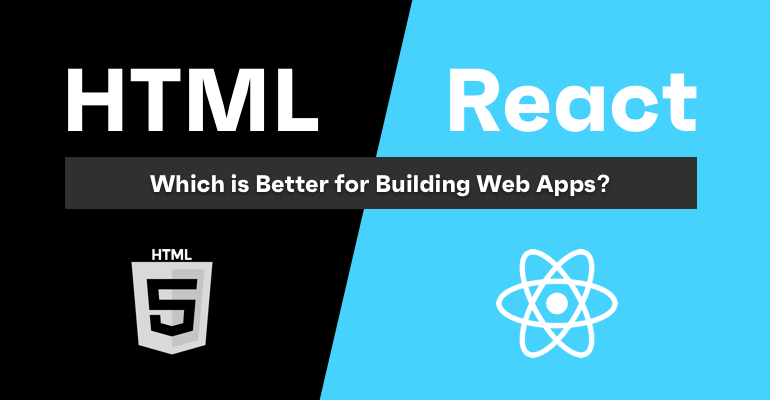Building web apps requires choosing the right technology stack to ensure scalability, performance, and a smooth user experience. HTML and React are two of the most widely used technologies for building web applications. While HTML is the foundation of web development, React has gained popularity for its dynamic capabilities and component-based architecture. In this article, we’ll compare HTML and React in detail, including their pros, cons, and best use cases, to help you decide which is better for your project.
What is HTML?
HTML (HyperText Markup Language) is the standard language for creating web pages and web applications. It defines the structure and content of a webpage using a series of elements and tags. HTML is essential for displaying static content and is the backbone of every website.
Features of HTML:
✅ Simple and easy to learn
✅ Lightweight and fast loading
✅ Supported by all browsers
✅ Works seamlessly with CSS and JavaScript
Example of Basic HTML Code:
<!DOCTYPE html>
<html>
<head>
<title>Sample HTML Page</title>
</head>
<body>
<h1>Hello, World!</h1>
<p>This is a basic HTML example.</p>
</body>
</html>
Pros of HTML:
✔️ Easy to learn and implement
✔️ Fast rendering since it’s lightweight
✔️ No additional setup or installation required
✔️ Works with all web browsers
Cons of HTML:
❌ Limited functionality for dynamic content
❌ Not suitable for complex web apps
❌ Requires CSS and JavaScript for interactivity
What is React?
React is an open-source JavaScript library developed by Facebook for building user interfaces, especially for single-page applications (SPAs). React allows developers to create reusable components and manage state efficiently, making it ideal for dynamic and interactive web applications.
Features of React:
✅ Component-based architecture
✅ Virtual DOM for faster updates
✅ State management with hooks and context
✅ Strong community support
Example of a Simple React Component:
import React from 'react';
function App() {
return (
<div>
<h1>Hello, World!</h1>
<p>This is a basic React example.</p>
</div>
);
}
export default App;
Pros of React:
✔️ Reusable components reduce development time
✔️ Efficient updates with Virtual DOM
✔️ Strong ecosystem with libraries and tools
✔️ State management for complex apps
Cons of React:
❌ Learning curve for beginners
❌ Requires setting up build tools (Webpack, Babel)
❌ Performance issues for very large apps without optimization
HTML vs React: Key Differences
| Feature | HTML | React |
|---|---|---|
| Type | Markup Language | JavaScript Library |
| Usage | Static websites | Dynamic web apps |
| Complexity | Simple | Moderate to complex |
| Performance | Fast for static pages | Fast for dynamic apps |
| Reusability | No component-based structure | Component-based architecture |
| Learning Curve | Easy | Moderate |
| SEO | Good for static content | Requires server-side rendering for better SEO |
| Scalability | Limited | High |
When to Use HTML
👉 Use HTML if you’re building:
- Static websites (e.g., portfolios, landing pages)
- Simple one-page sites
- Projects with minimal interactivity
Example Use Case:
- A personal blog or resume site with static content.
When to Use React
👉 Use React if you’re building:
- Single-page applications (SPAs)
- Complex web apps with dynamic content
- Apps that require state management
Example Use Case:
- A social media platform where real-time updates are needed.
Performance Comparison
✅ HTML is lightweight and fast because it’s a simple markup language.
✅ React is fast for dynamic content because it uses Virtual DOM for quick updates.
✅ HTML is better for small websites, while React scales better for complex apps.
SEO Impact
- HTML is naturally SEO-friendly because search engines can easily crawl and index static content.
- React requires Server-Side Rendering (SSR) or Static Site Generation (SSG) to improve SEO performance since React apps are single-page applications.
- Using libraries like Next.js can help optimize React apps for SEO.
Security
- HTML is secure by default since it doesn’t execute scripts.
- React requires careful handling of XSS (Cross-Site Scripting) and other vulnerabilities.
- React’s security can be improved using libraries like Helmet.
Development Time
- HTML requires less development time for small and static websites.
- React reduces development time for complex projects by reusing components and handling state efficiently.
Cost and Resources
- HTML requires fewer resources and is cheaper to develop.
- React requires a skilled developer and a more advanced tech stack, increasing costs.
Conclusion
Both HTML and React have their strengths and ideal use cases. HTML is perfect for static websites, landing pages, and small projects due to its simplicity and browser compatibility. React, on the other hand, excels in building complex, dynamic web applications thanks to its component-based structure and Virtual DOM.
At XHTMLTEAM, we follow best SEO practices in our code to make your site SEO-optimized and search-engine friendly. Our team ensures fast page loading, clean HTML structure, and efficient use of meta tags and schema markup to help your website rank higher on Google. We also leverage the latest React features to build scalable, high-performance web applications tailored to your business needs.
Need expert help with HTML or React development?
👉 Contact XHTMLTEAM today and take your web development to the next level!

